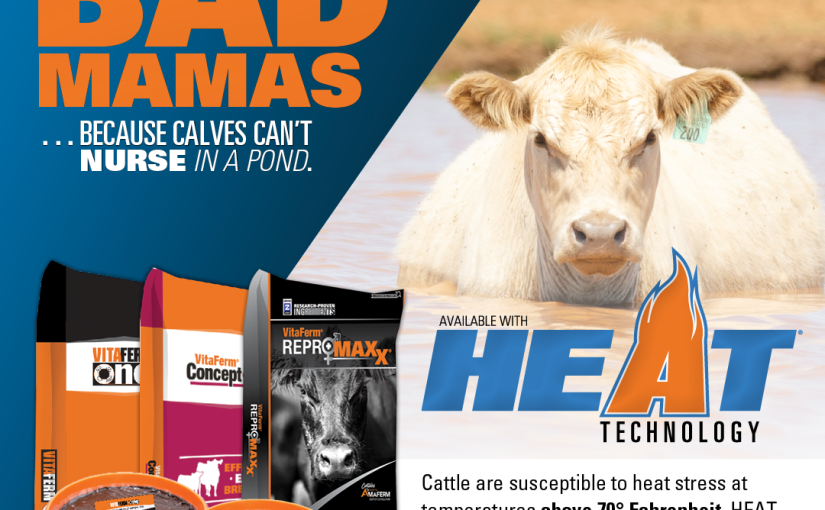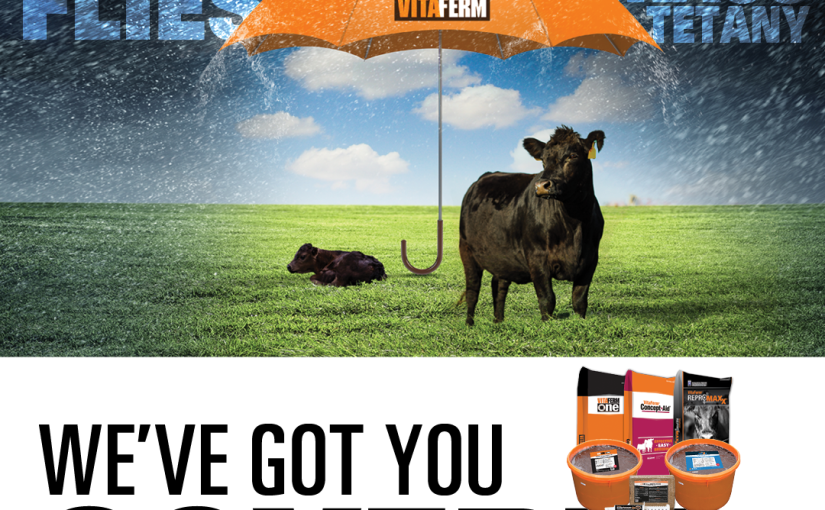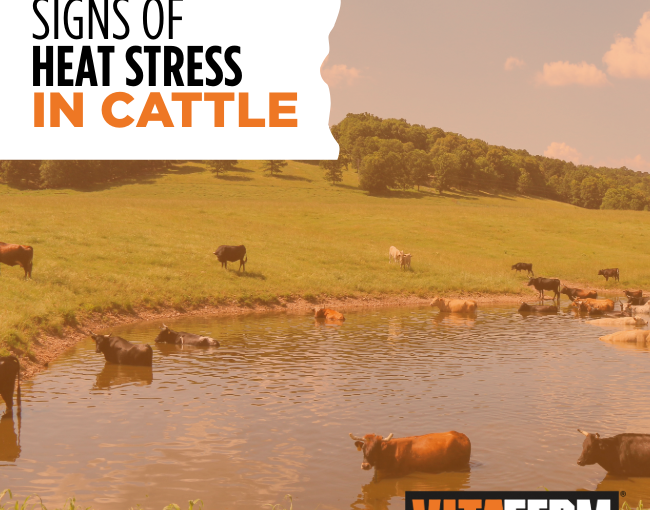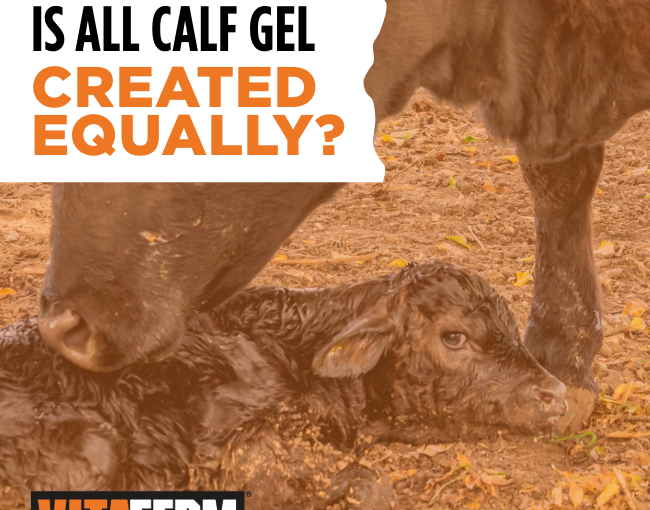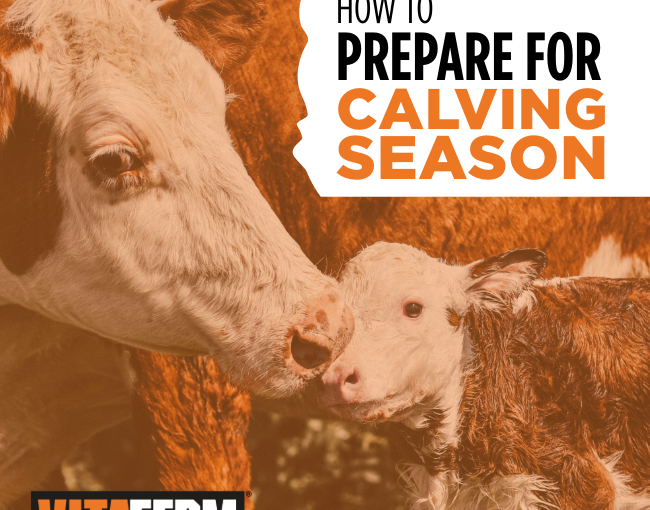Summer brings multiple challenges to cattle producers, including but not limited to insects and heat stress. Cattle are more resilient than we often think. However, the combination of heat and humidity can still wreak havoc on the health of the cow herd. When your customers identify signs of heat stress in cattle early on, they will need a quality supplement from VitaFerm® to help mitigate that stress.
At BioZyme®, our mission is to create products that provide solutions. We know that heat stress is a challenge that producers face across the country. We want to provide you, our dealers, with the most comprehensive options available to fit your customers’ needs.
Let’s discuss heat stress, the signs of heat stress in cattle and how our products can work for cattle producers across the U.S. to mitigate heat stress this summer.
What is Heat Stress?
Heat stress occurs when the animal’s ability to release heat becomes inhibited due to the overwhelming high temperatures. Typically, heat stress isn’t caused by excessive heat alone; it is also triggered by high humidity and decreased air movement. Livestock, like humans, are most comfortable in their thermoneutral zone.
The Thermoneutral Zone (TNZ) is the environmental temperature range in which the least effort is required by an animal to regulate body temperature. In the TNZ, an animal is most comfortable, has the fastest growth rate, and achieves the most efficient feed-to-gain ratio. This temperature zone is highly variable and depends on several factors. Those include: species, humidity, time of year, age, acclimation, amount of fat or hair coat insulation, level of production, wind, and other factors. That’s according to a Washington State University Extension Fact Sheet.
Heat Stress Cases Vary
It’s important to point out that cattle response varies by geographical location and breed makeup when discussing heat stress.
“The unfortunate part is everybody’s situation is different based on regional climate differences,” said Chris Cassady, Ph.D., Director of Beef Technical Sales at BioZyme® Inc.
“Where a backgrounder in Texas might have to deal with severe heat for seven months, someone in North Dakota might have extreme heat for just two months. However, the commonality is understanding the cascade of events associated with heat stress – symptoms to look for and what to do.”
Signs of Heat Stress in Cattle
During the summer, producers should take extra care to look over their livestock regularly to monitor factors that can lead to heat stress. Encourage your customers to watch for behavioral and physical signs that animals are experiencing heat stress so they can effectively mitigate it before it turns fatal.
Heat stress can have significant implications for cattle health, productivity and well-being, especially during hot and humid weather conditions. Recognizing the signs of heat stress in cattle is essential for implementing timely interventions to prevent heat-related illnesses and losses.
Increased Respiration Rate
The first visible sign of heat stress to look for is an increased respiration rate. Excessive or rapid panting, with extended periods of open-mouth breathing, is a sign of heat stress. Cattle that show this increase in respiration rate will have increased air volume intake, which can ultimately lead to other sicknesses. With increased air intake, animals are inhaling more dust, dirt, bacteria and viruses into their bodies, which can quickly lead to bigger problems. Elevated respiratory rates indicate the animal’s effort to cool down and maintain thermal equilibrium.
Seeking Shade, Shelter & Water
When battling heat stress, cattle often tell you what they need. The most common sign of heat stress is animals seeking out shade and water during the peak heat of the day. This disrupts the normal feeding pattern of continuously grazing and consuming smaller meals.
That distraction shifts to night grazing and slug feeding, where they eat more at once due to increased hunger. Slug feeding leads to acidosis and bloat in ruminants, which can lead to more health issues or death. When cows bunch up, they are more likely to be exposed to sickness because of shared germs – compare them to school kids inside all winter with little fresh air.
Heat-stressed cattle may seek shade, shelter or cool, shaded areas. This is to escape direct sunlight and reduce heat exposure. Providing adequate shade structures and shelter options can help mitigate the effects of heat stress.
Cattle experiencing heat stress may increase their water consumption to maintain hydration and regulate body temperature. Providing access to clean, fresh water is crucial during periods of heat stress to prevent dehydration and electrolyte imbalances.
Decreased Feed Intake
Heat-stressed cattle may reduce their feed intake due to decreased appetite and metabolic heat production. Reduced feed consumption can lead to decreased nutrient intake and weight loss, impacting overall productivity and performance.
Other Signs & Symptoms
Other typical signs of heat stress in cattle include lethargy, drooling, aimless wandering or staggering and—in severe cases—ultimately death. In addition, increased body temperature and increased heart rate are also symptoms of heat stress.
Cattle struggle to hide these symptoms, so recognizing these signs early allows producers to implement proactive measures. This can alleviate heat stress and minimize its impact on animal health and performance.
Implementing management practices to reduce heat load is critical for mitigating the effects of heat stress in cattle.
Effects of Heat Stress
It’s worth mentioning that some effects of heat-stressed cattle aren’t immediately obvious. They can be long-lasting and detrimental to the overall health of your herd.
Heat stress can be detrimental to the herd both from a performance and reproductive standpoint. Animals that are not eating or grazing are not gaining weight. Heat stress can cause shorter gestation lengths, resulting in lighter birth weights and immune-compromised offspring.
Extreme heat is a major cause of poor reproductive performance. Females can face problems initiating and maintaining pregnancy. The males can become sterile and also experience a lack of libido.
Hot Cows Make Bad Mamas
The added heat can be debilitating to animals, especially when combined with humidity. Hot cows make bad mamas for several reasons. Why, you might ask. The reasons are listed in the signs of heat stress in cattle that we listed above, but we’ll describe some specific examples:
- First, if a cow tries to cool off in a pond or bunches under shade, their calf isn’t nursing. A calf that isn’t nursing isn’t gaining. Last we checked; the goal was to wean off pounds.
- Next, with summer comes breeding season, and we want to help you get them bred and keep them bred.
Thankfully, BioZyme has HEAT® technology to keep those mamas cool, get them bred and keep them bred. With the realignment of the VitaFerm brands into the good, better, best – VitaFerm® ONE, Concept•Aid® and ReproMaxx™ – we have repositioned HEAT away from its own line. HEAT is now a technology, allowing us to incorporate it into more brands and lines than ever before! This lets you promote and market the HEAT technology to more customers, making a bigger impact.
What’s in the HEAT Technology?
HEAT Technology is comprised of:
- A proprietary blend of essential oils supports animals when heat is a challenge.
- Garlic helps deter insects.
“The proprietary blend of capsaicin and essential oils in HEAT technology helps improve blood flow to the extremities,” Cassady said. “When the benefit of improved rumen function of Amaferm is tied with the HEAT technology, you can be assured your cows will be grazing even in the most extreme temperatures. They won’t be huddled under the shade trees.”
More Choices with HEAT Technology
Now, your customers have more product choices with HEAT technology, including:
VitaFerm® ONE HEAT® _ A free choice vitamin & mineral supplement for beef cattle that promotes cattle performance when temperatures are above 70 degrees Fahrenheit or when cattle are grazing fescue.
NEW: VitaFerm® ONE HEAT® with ClariFly® _ A free choice vitamin & mineral supplement for beef cattle with ClariFly. It promotes cattle performance when temperatures are above 70 degrees Fahrenheit or when cattle are grazing fescue.
VitaFerm® ONE HEAT® CTC 3G with ClariFly® _ A free choice vitamin & mineral supplement with ClariFly and CTC for beef cattle. It promotes cattle performance when temperatures are above 70 degrees Fahrenheit or when cattle are grazing fescue. CTC helps control anaplasmosis.
NEW: VitaFerm® ONE HEAT® Mineral Tub – A free choice vitamin & mineral supplement for beef cattle in a cooked tub that promotes cattle performance year-round.
VitaFerm® Concept•Aid® 5/S HEAT® – A premium free choice 5% phosphorus vitamin & mineral supplement for beef cattle. It supports reproductive success when temperatures are above 70 degrees Fahrenheit or when cattle are grazing fescue.
VitaFerm® Concept•Aid® 5/S HEAT® with ClariFly® – A premium free choice 5% phosphorus vitamin & mineral supplement with ClariFly for beef cattle. It supports reproductive success when temperatures are above 70 degrees Fahrenheit or when cattle are grazing fescue.
VitaFerm® Concept-Aid® 5/S HEAT® CTC 3G – A premium free choice 5% phosphorous vitamin & mineral supplement with CTC for beef cattle. It supports reproductive success when temperatures are above 70 degrees Fahrenheit or when cattle are grazing fescue. CTC helps control anaplasmosis.
NEW: VitaFerm® ReproMaxx™ HEAT® – A premium free choice vitamin & mineral supplement for beef cattle. It maximizes reproductive success when temperatures are above 70 degrees Fahrenheit or when cattle are grazing fescue. Includes research-proven levels of Zinpro organic trace minerals.
VitaFerm® HEAT® Tub – A vitamin & mineral tub for beef cattle that supports overall health when temperatures are above 70 degrees Fahrenheit or when cattle are grazing fescue.
VitaFerm® HEAT® Stress Tub – A tub for beef cattle that supports digestive health and intake when temperatures are above 70 degrees Fahrenheit. (Formerly known as Vita Charge HEAT Stress Tub.)
Gain Smart® Stocker HEAT® – A free choice vitamin & mineral supplement for stocker cattle that maximizes efficient gain when temperatures are above 70 degrees Fahrenheit.
Stock up on HEAT Products Today
Spring is here, and HEAT season is right around the corner or perhaps already here in some geographic locations. It’s time to start watching for signs of heat stress in cattle and stocking up on products with HEAT technology for your customers.
Dealer Support Available
At BioZyme, we want to support our dealers as much as we can. Watch for marketing support materials in the SAMM Center. We’ll have print ads, postcards and invoice stuffers.
Also, look for social media graphics in our Social Media Toolbox.
Finally, look for the Heat Stress session in the Master Dealer – ON DEMAND Training Sessions. This brief overview supports everything we’ve covered and more about signs of heat stress in cattle the products you can offer your products.
